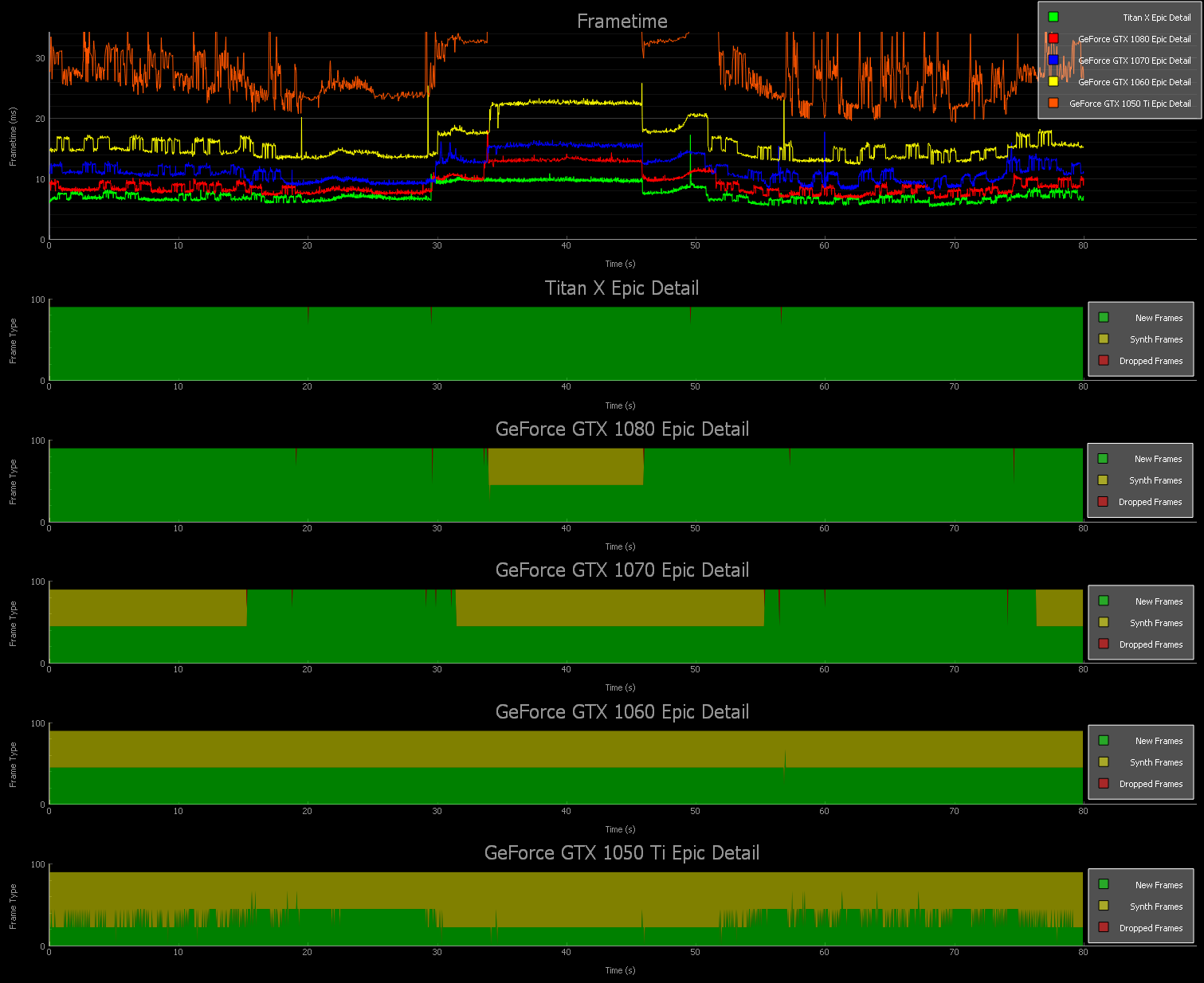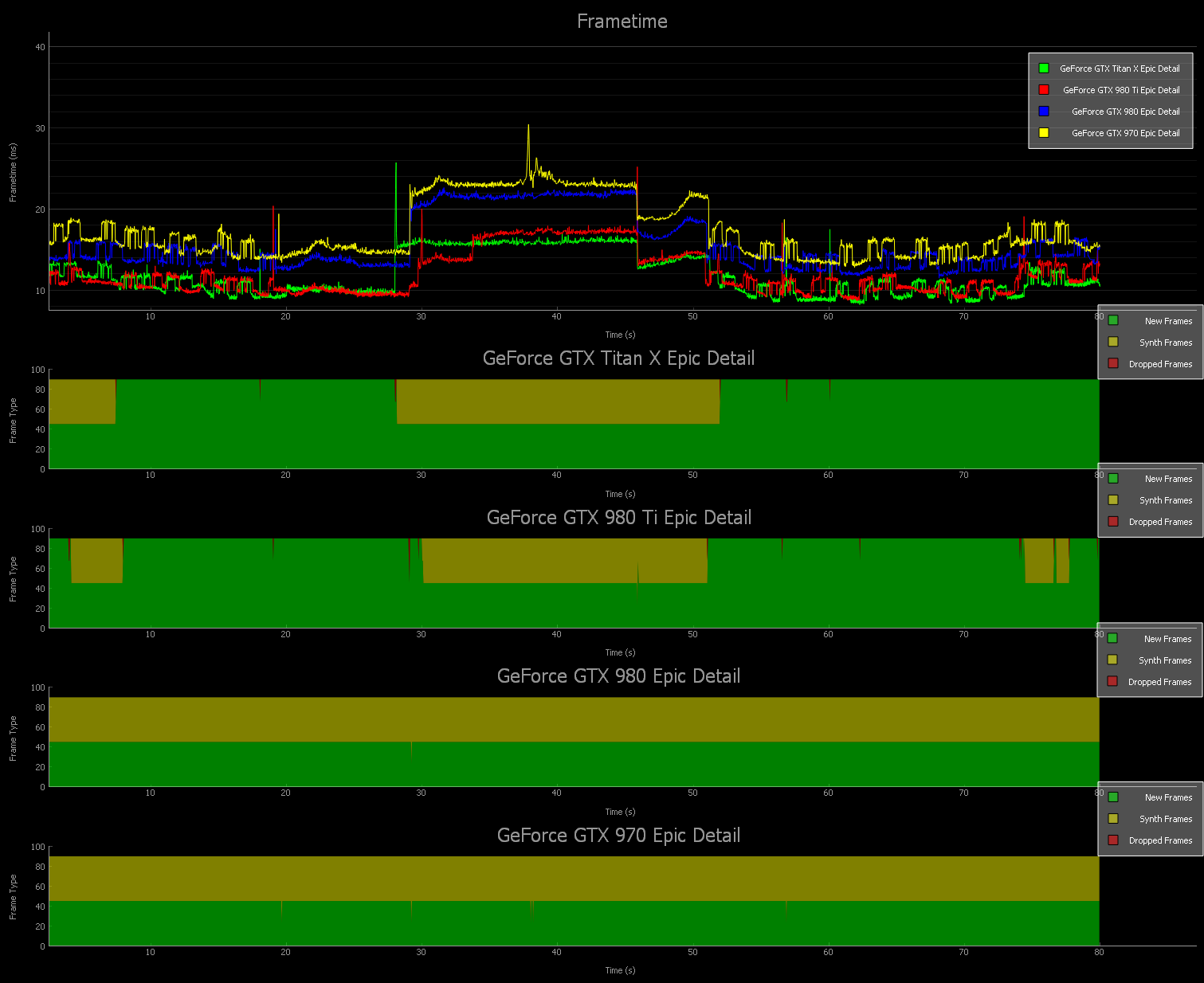FCAT VR: GPU And CPU Performance in Virtual Reality
Nvidia: Pascal and Maxwell Performance
Despite VR’s relative youth, there are already endless combinations of graphics cards, games, and quality settings we could test to start characterizing performance. Before we start exploring other titles (or indeed, other HMDs), though, let’s feel out the VR-capable hardware from Nvidia’s Pascal and Maxwell architectures using the same demanding sequence from Chronos using Epic detail settings.
We already know the Titan X is a best-case scenario for this game—it drops a scant four frames and never needs ASW to deliver 90 real frames per second through our benchmark.
The GeForce GTX 1080’s performance deficit is large enough that ASW does kick in for 541 frames in the middle of our test. Across the run, its unconstrained frame rate is just north of 112, whereas the Titan X averages more than 134 FPS.
As we’ve already seen, a GeForce GTX 1070 spends even more time in ASW mode—Nvidia’s VR Analyzer shows it synthesizing more than 2000 frames and dropping 13 (more than any other Pascal-based card). A ~90 FPS unconstrained rate drops to ~65 delivered FPS when you take into account the 90 Hz display interval and roughly half the run spent at 45 Hz in ASW mode.
Dropped frames aren’t an issue on the GeForce GTX 1060 6GB. Its entire run is spent in ASW mode, yielding an even 45 delivered frames per second. While that sounds nice and tidy, we’ve already shown you some of the artifacts associated with ASW. Gamers sensitive to the blur or fuzziness of spacewarp may prefer to adopt a lower quality preset, minimizing their reliance on it.
More problematic is the GeForce GTX 1050 Ti, which Oculus considers the lowest-end Pascal card that’s Rift-ready. Obviously, you’d want to dial in Recommended or Low settings in Chronos. But for the purpose of our comparison, FCAT’s VR Analyzer says 2703 of this run’s 7553 frames are new, while 4848 are synthesized. Though it seems implausible to create more frames in a given time period than are actually rendered, in their November 2016 blog post introducing ASW, Oculus’ Dean Beeler, Ed Hutchins, and Paul Pedriana mention that the technology doesn’t scale well below half of the display’s refresh rate. The suggestion there is that it still functions below half of the display’s refresh rate. Regardless, simply specifying a less demanding detail level should get you around whatever strangeness we observe.
Based on what we know about the Pascal and Maxwell architectures, and what we saw in the previous chart, these cards land pretty much where you might expect.
Get Tom's Hardware's best news and in-depth reviews, straight to your inbox.
The GeForce GTX Titan X and 980 Ti slightly underperform the 1070 with sub-90 FPS unconstrained rates. Interestingly, the Titan X spends more time in ASW mode synthesizing frames than the 980 Ti, but does achieve higher overall performance.
Technically, the GeForce GTX 980 hits roughly 64 unconstrained frames per second, while the 970 approaches 58. But because they dabble in a similar range, ASW mode remains active on both cards through our benchmark and they similarly deliver 45 FPS.
Current page: Nvidia: Pascal and Maxwell Performance
Prev Page The Effect of Quality Settings on Performance Next Page AMD: Graphics Core Next Performance-
AndrewJacksonZA A really nice article and a great introduction to FCAT VR. Thanks Chris!Reply
Obvious request that probably everyone will ask of you: please include Ryzen in your tests once you have a sane moment after the hectic launch period. :-)
Now that that's out the way, I can get to my actual question: I would like to know if "Game A" is available on both the Rift and the Vive, would FCAT VR be able to tell you what, if anything, the performance difference is given the same computer hardware please?
Please can you also include multi-GPU setups. They can definitely help, depending on the title, e.g.
https://www.hardocp.com/article/2016/11/30/serious_sam_vr_mgpu_nvidia_gtx_pascal_follow_up/5
https://www.hardocp.com/article/2016/10/24/serious_sam_vr_mgpu_amd_rx_480_follow_up/
I found this statement to be very interesting: "it’s possible to illustrate that 11ms isn’t an absolute threshold for rendering new frames at 90 Hz."
Thank you
Andrew -
cangelini Hi guys,Reply
Ryzen wasn't in my lab yet when this was written, but I do have plans there ;)
Andrew, yes, FCAT VR should allow us to test the same title on two different HMDs and compare their performance.
Multi-GPU is a plan as well, particularly once games begin incorporating better support for it (right now, that's a bit of a problem). -
playingwithplato Do FCAT VR's measurement algorithms tend to favor NVDIA chipsets? Curious, wonder if AMD will release a similar testing tool to measure buffer store/retrieval and render speed <11ms? Would like to see that applied to en environment with their GPUs.Reply -
ffrgtm Fantastic article! I would love to see results with a secondary GPU (non-SLi) dedicated to physics and compare that to the cpu swap tests in AZ Sunshine you've just shown us.Reply -
ffrgtm Reply
A quote from another article on FCAT:19429997 said:Do FCAT VR's measurement algorithms tend to favor NVDIA chipsets? Curious, wonder if AMD will release a similar testing tool to measure buffer store/retrieval and render speed <11ms? Would like to see that applied to en environment with their GPUs.
"While the FCAT VR tool is developed by Nvidia, the company insists it is headset and GPU agnostic, and meant only to capture data. The tool itself doesn’t contain a benchmark; according to the company, the tool logs information directly from the VR runtime."
I'm inclined to believe Nvidia's claim of brand blindness right now... but if AMD ever manages to put forth some real competition then I don't think we could be blamed for becoming more skeptical. It's hard to forget just how far Nvidia and AMD have gone to skew results in the past. -
AndrewJacksonZA Reply
Thank you.19429089 said:Andrew, yes, FCAT VR should allow us to test the same title on two different HMDs and compare their performance.
Multi-GPU is a plan as well, particularly once games begin incorporating better support for it (right now, that's a bit of a problem).
One thing that I might've missed in the article: Has Nvidia open-sourced FCAT and FCAT VR so that everyone can see the code, check it for unbiasedness (is that even a word? :-) and help contribute to the program to make it even better? -
cangelini Yup, check it out: http://www.geforce.com/whats-new/guides/fcat-vr-download-and-how-to-guideReply
There's a download link in there. I'd be curious to hear from any TH readers who want to mess with it as well! -
thinkspeak Any chance of doing this again but with stock and OC on the maxwell, pascal and AMD cards? The 980 ti really opens up and they generally overclock well, in some cases exceeding the 1070 which would be useful for those debating an upgrading for VRReply


